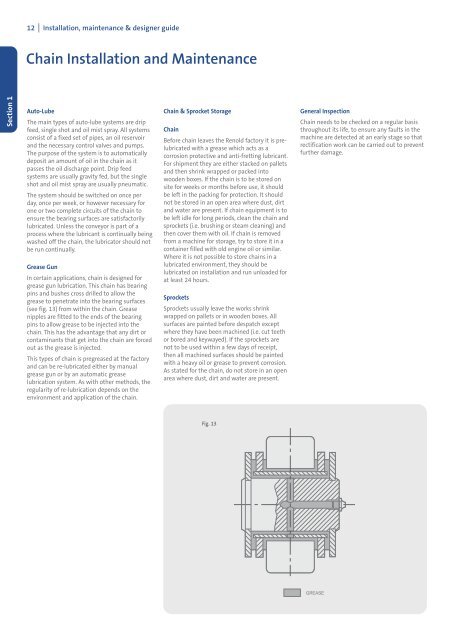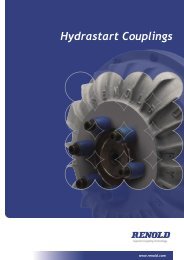Conveyor chain
Conveyor chain
Conveyor chain
You also want an ePaper? Increase the reach of your titles
YUMPU automatically turns print PDFs into web optimized ePapers that Google loves.
Section 1<br />
12 I Installation, maintenance & designer guide<br />
Chain Installation and Maintenance<br />
Auto-Lube<br />
The main types of auto-lube systems are drip<br />
feed, single shot and oil mist spray. All systems<br />
consist of a fixed set of pipes, an oil reservoir<br />
and the necessary control valves and pumps.<br />
The purpose of the system is to automatically<br />
deposit an amount of oil in the <strong>chain</strong> as it<br />
passes the oil discharge point. Drip feed<br />
systems are usually gravity fed, but the single<br />
shot and oil mist spray are usually pneumatic.<br />
The system should be switched on once per<br />
day, once per week, or however necessary for<br />
one or two complete circuits of the <strong>chain</strong> to<br />
ensure the bearing surfaces are satisfactorily<br />
lubricated. Unless the conveyor is part of a<br />
process where the lubricant is continually being<br />
washed off the <strong>chain</strong>, the lubricator should not<br />
be run continually.<br />
Grease Gun<br />
In certain applications, <strong>chain</strong> is designed for<br />
grease gun lubrication. This <strong>chain</strong> has bearing<br />
pins and bushes cross drilled to allow the<br />
grease to penetrate into the bearing surfaces<br />
(see fig. 13) from within the <strong>chain</strong>. Grease<br />
nipples are fitted to the ends of the bearing<br />
pins to allow grease to be injected into the<br />
<strong>chain</strong>. This has the advantage that any dirt or<br />
contaminants that get into the <strong>chain</strong> are forced<br />
out as the grease is injected.<br />
This types of <strong>chain</strong> is pregreased at the factory<br />
and can be re-lubricated either by manual<br />
grease gun or by an automatic grease<br />
lubrication system. As with other methods, the<br />
regularity of re-lubrication depends on the<br />
environment and application of the <strong>chain</strong>.<br />
Chain & Sprocket Storage<br />
Chain<br />
Before <strong>chain</strong> leaves the Renold factory it is prelubricated<br />
with a grease which acts as a<br />
corrosion protective and anti-fretting lubricant.<br />
For shipment they are either stacked on pallets<br />
and then shrink wrapped or packed into<br />
wooden boxes. If the <strong>chain</strong> is to be stored on<br />
site for weeks or months before use, it should<br />
be left in the packing for protection. It should<br />
not be stored in an open area where dust, dirt<br />
and water are present. If <strong>chain</strong> equipment is to<br />
be left idle for long periods, clean the <strong>chain</strong> and<br />
sprockets (i.e. brushing or steam cleaning) and<br />
then cover them with oil. If <strong>chain</strong> is removed<br />
from a machine for storage, try to store it in a<br />
container filled with old engine oil or similar.<br />
Where it is not possible to store <strong>chain</strong>s in a<br />
lubricated environment, they should be<br />
lubricated on installation and run unloaded for<br />
at least 24 hours.<br />
Sprockets<br />
Sprockets usually leave the works shrink<br />
wrapped on pallets or in wooden boxes. All<br />
surfaces are painted before despatch except<br />
where they have been machined (i.e. cut teeth<br />
or bored and keywayed). If the sprockets are<br />
not to be used within a few days of receipt,<br />
then all machined surfaces should be painted<br />
with a heavy oil or grease to prevent corrosion.<br />
As stated for the <strong>chain</strong>, do not store in an open<br />
area where dust, dirt and water are present.<br />
Fig. 13<br />
General Inspection<br />
Chain needs to be checked on a regular basis<br />
throughout its life, to ensure any faults in the<br />
machine are detected at an early stage so that<br />
rectification work can be carried out to prevent<br />
further damage.




